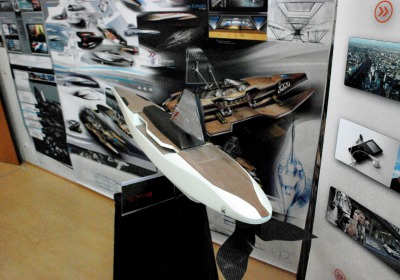Strate College degree show 2009
Wed, 01 Jul 2009Graduating students from Strate College in Paris, France displayed their final projects in a degree show held at the school's temporary facility late last month. Founded in 1993, the school has outgrown its rented facility and is in the process of relocating to a new purpose-built facility, which will be completed at the start of the next school year. Of the 60 students studying various disciplines, the design exhibition also included the works of 16 students in the Transportation Mobility program.
Rapid Crisis System
Anthony Colard
Rather than simply designing a single project, Colard created an entire rescue system for the year 2040 consisting of three parts: a 190m Zeppelin balloon-like flying base called the Orion, a 'Caudron' helicopter/plane hybrid and an assortment of modules to deal with various natural disasters. Colard told CDN he had chosen to create all three because it was "Nice to present an object but better to create an entire universe." His goal was to explore aerodynamics by conducting research to develop a vessel adapted to respond quickly to natural disasters worldwide. The main project was the 28m Caudron, named after the historic French aircraft company. It combines the attributes of a plane and a helicopter for the precise delivery of large loads and features rotors that fold away into the main structure and a cockpit at the rear.
Link Up system
Laurent Gravier
This self-service urban mobility vehicle targets active professionals living in cities. According to Gravier, the car's place in urban centers is being questioned. He has therefore developed a two person vehicle which would be structurally connected to other means of public transportation such as the metro, bus and train. In this depiction, the Link Up concept is provided by the RATP at train stations. Measuring 2600mm long and 1360mm high, the electrically-powered vehicle is also partially foldable. When parked the rear wheels move forward, shortening the wheelbase while raising the car's body and minimizing its footprint when not in use. The concept also features an interactive display on the windscreen.
Asgard
Nicolas Souliman
The 156m Asgard is a boat project created to rekindle the relationship between man and sea. Intended for trans-oceanic travel, the cruise ship can carry 750-800 passengers inside a contemporary, asymmetrical open space. The streamlined design features cutout windows in the floor to gaze at the ocean passing below. Propelled primarily by a hydrogen turbine harnessing power through the sun as well as algae, the trimaran concept also features a kite, hydrofoils for stability and speed, and air injectors to lubricate the vessel's passage through water.
BYD Chuan concept
Shuai Feng
Inspired by the Chinese landscape, sculpture, paintings and origami, this four seat vehicle is meant to communicate Chinese culture and spirit. Drawing inspiration from the country's 5000 year history and its progress in technology, Feng created a vehicle for medium- or long-distance trips in the year 2030. Measuring 5050mm long, 2100mm wide and 1310mm high, the project emphasizes Chinese culture's love of big cars with organic forms and flying buttresses at the rear (for improved aerodynamics). "I want to marry Chinese brush strokes, origami and sculpture, with an Asian allure and fluidity in the lines," said Feng. The interior, inspired by Chinese royal families from the Tang and Han Dynasties, features tactile control panels to operate a slew of new technologies.
Ikkar
Julien Anglade
The Ikkar cruise ship is the missing link between yachts and mega ships. Starting from the premise that cruise ships have now become buildings on water; creating a dehumanized, anesthetized relationship with nature, Anglade's goal was to re-establish the relationship between man and sea. The 150m yacht can accommodate 60 people and a 50 person crew. Strongly influenced by Frank Ghery and Norman Foster architecture, the narrow, energy-efficient boat is fitted with luxurious appointments inspired by Trans-Atlantic vessels of the 1930s and its form morphs to emphasize the different transitions along the journey.
Continues →
By Eric Gallina

